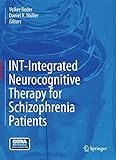INT-Integrated Neurocognitive Therapy for Schizophrenia Patients [electronic resource] / edited by Volker Roder, Daniel R. Müller.
Material type: TextPublisher: Cham : Springer International Publishing : Imprint: Springer, 2015Edition: 1st ed. 2015Description: X, 141 p. 37 illus., 28 illus. in color. online resourceContent type:
TextPublisher: Cham : Springer International Publishing : Imprint: Springer, 2015Edition: 1st ed. 2015Description: X, 141 p. 37 illus., 28 illus. in color. online resourceContent type: - text
- computer
- online resource
- 9783319132457
- 616.89 23
- RC466.8
| Item type | Current library | Home library | Collection | Status | Barcode | |
|---|---|---|---|---|---|---|
 E-books
E-books
|
Library and Information Centre | Library and Information Centre | SN | Available | EBK53230 |
Preface -- Foreword -- Theoretical Background -- Practical Implementation of INT -- Therapy Requirements, Possible Applications and Indication -- Diagnostic Instruments, Treatment Planning and Controlling the Treatment Process -- Empirical Evidence of INT -- Therapy Materials for the Four Treatment Areas -- Index.
Integrated Neurocognitive Therapy (INT) is a cognitive remediation therapy approach. INT is the first treatment manual comprising all MATRICS areas (Measurement and Treatment Research to Improve Cognition in Schizophrenia). The NIMH (National Institute of Mental Health, USA) initiated this MATRICS initiative. MATRICS defines 11 neurocognitive and social cognitive areas of functioning being relevant for patients with schizophrenia. The improvement of these areas in a group therapy is the main goal of INT. INT is based on IPT (Integrated Psychological Therapy, Roder et al 2010). It is a resource and a recovery oriented intervention to enhance also therapy motivation and self-esteem and to reduce negative symptoms. Therapy focuses especially on group processes and the exercises augment transfer and generalisation to daily life. As a meta goal INT intends to amend life quality and the reintegration of the patients in the community. The presented manual offers the clinicians a practically orientated guide for carrying out INT. The techniques and exercises (partly computer-based) are described in detail. Case examples point out specific therapeutic situations and teach the therapist how to cope with complicated group and individual demands. Assessment for patient selection, differential indication and therapy control within a multi-dimensional treatment and rehabilitation system are discussed. INT was evaluated successfully in an international randomised multi-centre study. In the meantime it is implemented in many clinical settings in German speaking countries. .
There are no comments on this title.

